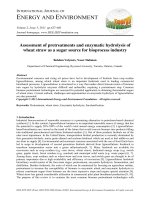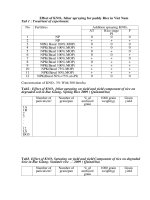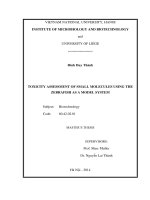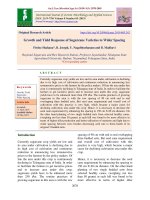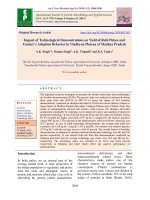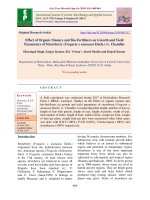Comparative yield potential of various pleurotus spp./ strains of himachal pradesh using wheat straw as substrate
Bạn đang xem bản rút gọn của tài liệu. Xem và tải ngay bản đầy đủ của tài liệu tại đây (208.78 KB, 6 trang )
Int.J.Curr.Microbiol.App.Sci (2018) 7(7): 2155-2160
International Journal of Current Microbiology and Applied Sciences
ISSN: 2319-7706 Volume 7 Number 07 (2018)
Journal homepage:
Original Research Article
/>
Comparative Yield Potential of Various Pleurotus spp./ Strains of Himachal
Pradesh using Wheat Straw as Substrate
Rishu Sharma* and B.M. Sharma
CSKHPKV, Palampur, H. P- 176062, India
Corresponding author
ABSTRACT
Keywords
Pleurotus, Spawn
run, Pinning
initiation, Wheat
straw, Substrate
Article Info
Accepted:
17 June 2018
Available Online:
10 July 2018
A total of 21 isolates of Pleurotus were procured/ collected from different sources, for
conducting studies on yield potential using wheat straw as substrate. The species of genus
Pleurotus show great diversity in their adaptation to varying agro-climatic conditions.
Various species/strains of Pleurotus were collected/procured from different sources.
Majority of the species/strains were collected from the natural habitat during surveys
conducted in different localities of Himachal Pradesh during monsoon months of the year.
Some of the species were procured from NRCM Solan. Isolations from the fresh specimen,
collected from the wild were made following the standard tissue culture technique.
Experimental fruiting of 21 isolates under mushroom house conditions revealed that the
spawn run (11.6 days) and pinning initiation (16.6 days) was quick in Pleurotus sp. III
followed by P. sapidus and Pleurotus sp. I. Maximum biological efficiency of 92 per cent
was recorded in P. flabellatus I on the basis of two flushes.
Introduction
Pleurotus species constitute one of the
choicest edible mushrooms, known by several
names all over the world as ‘Hiratake’,
‘Shimaji’ or ‘Houbitake’ (Mizuno and
Zhuang, 1995; Bononi et al., 1995). However,
it is commonly known as ‘Oyster Mushroom’
and in India recognized by the name ‘Dhingri
Mushroom’. The species of Pleurotus are
generally saprophytic and wood destroying
fungi attacking both cellulose and lignin
components of wood and are widespread in
the temperate zones of the world (Zadrazil and
Kurtzman, 1984). The species of Pleurotus
grow wild in the forests of hilly areas and
cultivated in temperate and sub-tropical
regions of the world. These mushrooms are
grown on unfermented cereal straws with
good productivity. Oyster mushroom is well
known for its culinary properties and broad
adaptability under varied agro-climatic
conditions. In terms of total world production
of mushrooms in 2005 which is 5 million tons,
Pleurotus constitutes 25 per cent and ranks
second among the cultivated mushrooms
(Anonymous, 2007). In 1997, Pleurotus
production in world was reported to be
875,600 tons contributing 14.2 per cent to the
total
world
mushroom
production.
Representatives of genus Pleurotus form a
heterogeneous group of edible species of high
2155
Int.J.Curr.Microbiol.App.Sci (2018) 7(7): 2155-2160
commercial importance (Zervakis et al.,
2004). The species of genus Pleurotus show
great diversity in their adaptation to the
varying agro-climatic conditions. This flexible
nature of the genus gives it more importance
than any other cultivated mushroom (Zadrazil
and Dube, 1992). Pleurotus spp. cultivation
was first started in the 19th century on tree
stumps (Flack, 1917). In India, Pleurotus
cultivation was standardized by Bano and
Srivastava (1962) utilizing P. flabellatus and
the first domesticated species was P.
ostreatus. Later, P. sajor-caju gained much
importance after Jandaik and Kapoor (1974)
first reported its cultivation on banana pseudo
stem and chopped paddy straw. Different
substrates have been used by several workers
for the cultivation of Pleurotus spp. viz. cotton
waste (Chang et al., 1981), jowar straw and
groundnut pod (Khandar et al., 1991), wheat
straw (Gupta and Langer, 1988), rubber wood
waste (Mathew et al, 1991). Thomas et al.,
(1998) have reported rice straw, as the most
widely used substrate in Asia for the
cultivation of Pleurotus spp. Mendeel et al.,
(2005) used cardboard, saw dust and plant
fibres for the cultivation of Pleurotus spp.
Similarly Mendez et al., (2005) utilized maize
and pumpkin straw as substrates. Several
diverse
substrates
like
lignocellulosic
materials (Yildiz et al., 2002), unpretreated
spent beer grains (Wang et al., 2001), banana
and rice straw (Bonatti et al., 2004), various
dry weed plants (Das and Mukherjee, 2007),
peat moss based substrate (Tawiah and
Martin, 2006) have also been used for the
cultivation of P. ostreatus. Silva et al., (2002)
have used cotton peel as substrate for P.
pulmonarius. Wheat bran supplemented with
umbrella plant was used for cultivation of P.
eryngii (Ohga and Royse, 2004). Thus, the
present study was carried out with the
objective to determine the high yielding
Pleurotus spp. using wheat straw as a
substrate. Also, it was planned to determine
which Pleurotus spp took minimum and
maximum days for spawn run, pinning
initiation and biological efficiency.
Materials and Methods
i) Collection, isolation and maintenance of
pure culture
Various species/strains of Pleurotus were
collected/procured from different sources.
Majority of the species/strains were collected
from the natural habitat during surveys
conducted in different localities of Himachal
Pradesh during monsoon months of the year.
Some of the species were procured from
NRCM Solan (Table 1). Isolations from the
fresh specimen, collected from the wild were
made following the standard tissue culture
technique (Gomborg, 2002). Young and fresh
specimens were first washed with a jet of
sterile water and cut across the pileal region
with the help of a sterilized sharp blade to get
2-3 mm bits. These bits were dipped in 0.1 per
cent Mercuric chloride solution with the help
of sterilized forceps for 5-10 seconds and were
given five washings in sterilized distilled
water and placed on sterilized filter paper to
remove excess moisture. The sterilized bits
were then transferred to Yeastal Potato
Dextrose Agar medium slants and incubated at
22 + 2oC. The stock cultures were maintained
in the refrigerator at 4oC. Sub-culturing of the
stock cultures was done after a period of 7-10
days on fresh YPDA slants.
ii) Preparation of spawn
Wheat grains were sieved for the removal of
undesirable materials and given 2-3 washings
with water in a wide mouth container. The
grains were then boiled in water for 15
minutes and soaked in hot water for 12-15
minutes. Water was decanted and the grains
were spread on a wire-mesh for 7-8 hours for
surface drying of grains. 18.0 g gypsum and
6.0 g calcium carbonate were added to one kg
2156
Int.J.Curr.Microbiol.App.Sci (2018) 7(7): 2155-2160
of wheat grains. 300 gms of boiled grains
were filled in glucose bottles upto two third of
the total volume, plugged with non-absorbent
cotton and autoclaved at 22 lbs p.s.i. pressure
at 126oC for 1.5 hours. Sterilized bottles were
kept in the room for 24 hours to remove the
excess moisture. The bottles were then kept
for overnight cooling in room, under the UV
light for 30 minutes. A 5 mm mycelial bit
from fresh culture was transferred aseptically
to one side of the bottle and another bit to the
other side of the bottle and kept at 22 + 2oC.
Incubated bottles were shaken weekly until
there was a complete mycelial colonization of
wheat grains. Fully colonized spawn bottles
were then used for spawning of the bags.
iii) Spawning
For conducting fruiting trials of various
species/strains, cloth bags were filled with 250
gms of wheat straw. The bags were dipped in
water overnight and were pasteurized in hot
water at 65-70oC for 6 hours and then boiled
in a drum for 1.5 to 2 hours. Wheat straw was
cooled after spreading on a sterilized
polythene sheet and tightly filled in
polypropylene bags having small holes for
aeration. Layer spawning was done and the
bags were tied at the top and properly labelled.
Spawned bags were kept in the mushroom
house (Temperature 22 + 2oC and relative
humidity 80-85%) for spawn run. After
complete spawn run, the bags were torn
opened and hanged with the help of plastic
rope on an iron frame for fruiting. The data on
spawn run, pinning initiation, fruiting
behaviour and yield pertaining to various
isolates were recorded.
Results and Discussion
A total of 21 isolates were collected /procured
from different sources to have a fairly large
sample size for determining the yield
attributes and potential of each collected
sample on wheat straw. Experimental fruiting
of 21 isolates under mushroom house
conditions revealed that the spawn run (11.6
days) and pinning initiation (16.6 days) was
faster in Pleurotus sp. III followed by P.
sapidus and Pleurotus sp. I (Table 2). Varying
period of spawn run and pinning initiation has
been reported for various species on different
substrates by several workers from time to
time (Baysal et al., 2003). All the 21 isolates
of Pleurotus were evaluated for their
spawning behaviour following the standard
technique (Munjal, 1973).
Table.2 Comparative yield potential of various Pleurotus species / strains on wheat straw
S.
No
SPECIES / STRAINS
SPAWN RUN
(DAYS)
1.
2.
3.
4.
5.
6.
7.
8.
9.
10.
11.
12.
Pleurotus eryngii I
Pleurotus sapidus
Pleurotus sp.I
Pleurotus florida
Pleurotus flabellatus II
Pleurotus ostreatus IV
Pleurotus flabellatus I
Pleurotus sp.II
Pleurotus ostreatus III
Pleurotus cornucopiae
Pleurotus eryngii II
Pleurotus sp.III
C.D (5%)
13.3
12.6
12.6
14.6
16.6
14.6
14.3
16.3
14.3
16.3
14.6
11.6
0.97
PINNING
INITIATION
(DAYS)
17.3
16.6
16.3
18.3
20.6
17.6
19.6
21.3
18.3
20.6
18.6
16.6
0.97
2157
YIELD (g/250g
dry substrate)
BIOLOGICAL
EFFICIENCY (%)
200.0
205.0
214.1
218.3
220.8
190.8
230.0
107.5
211.6
227.5
226.6
225.8
5.99
80.0
82.0
85.6
87.3
88.3
76.3
92.0
43.0
84.6
91.0
90.6
90.3
2.39
Int.J.Curr.Microbiol.App.Sci (2018) 7(7): 2155-2160
Table.1 Source of collection of various Pleurotus species/strains
SOURCE
NAME
SPECIES /STRAINS
Collection from wild
P11
P5
P21
P3
P4
P12
P6
P8
P10
P18
P19
P20
P7
P15
P17
Pleurotus sp.II
Pleurotus cystidiosus I
Pleurotus ostreatus IV
Pleurotus flabellatus II
Pleurotus cornucopiae
Pleurotus cystidiosus II
Pleurotus pulmonarius
Pleurotus fossulatus I
Pleurotus fossulatus II
Pleurotus sp.IV
Pleurotus sp.V
Pleurotus ostreatus III
Pleurotus sp.I
Pleurotus sp.III
Pleurotus eryngii II
NRCM, Solan
P1
P2
P9
P13
P14
P16
Pleurotus sapidus
Pleurotus flabellatus I
Pleurotus florida
Pleurotus ostreatus I
Pleurotus eryngii I
Pleurotus ostreatus II
Fig.1 Various fructified isolates of Pleurotus spp. under the mushroom house conditions
2158
Int.J.Curr.Microbiol.App.Sci (2018) 7(7): 2155-2160
The experimental fruiting trials were
conducted under the mushroom house
conditions. However, among 21 isolates only
twelve showed fructification (Fig. 1). The
fruiting trials were observed to note the
various attributes. It was observed that the
spawn run (11.6 days) and pinning initiation
(16.6 days) was quick in Pleurotus sp. III
followed by P. sapidus and Pleurotus sp. I.
Maximum biological efficiency of 92 per cent
was recorded in P. flabellatus I on the basis of
two flushes. Mendeel et al., (2005) evaluated
the biological efficiency of three Pleurotus
species namely P. columbinus, P. sajor-caju
and P. ostreatus on organic wastes, reported a
maximum biological efficiency (134.5%) in
P. columbinus on cardboard. Similarly, we
also got a higher biological efficiency of 91%
in P. cornucopiae. Though, further studies are
required to ascertain the best substrate using
the different substrates for the cultivation of
Pleurotus spp./strains.
Acknowledgement
Authors are grateful to National Horticultural
Board for the financial assistance and
Department of Plant Pathology, CSHPKV,
Palampur, Himachal Pradesh for cooperating
us in conducting this experiment
References
Anonymous (2007). Mushroom Production
Baysal, E., Pecker, H., Yalinkilic, M. F. and
Temiz, A (2003). Cultivation of oyster
mushroom on waste paper with some
added
supplementary
materials.
Bioresource Technology 89(1): 95-97.
Bonatti, M., Karnopp, P., Soares, H.M. and
Furlan, S. A (2004). Evaluation of
Pleurotus ostreatus and Pleurotus
sajor-caju nutritional characteristics
when
cultivated
in
different
lignocellulosic
wastes.
Food
Chemistry 88(3): 425-428.
Bano, Z. and Srivastava, H.C (1962). Studies
on the cultivation of Pleurotus species
on paddy straw. Food Science 11: 3638
Bononi, V.L.; Capelari, M.; Maziero, R.;
Trufem, S.F.B (1995). Cultivo de
cogumelos comestíveis São Paulo:
Ícone,. pp. 206.
Chang, S.T., Lau, O.W. and Cho, K.Y (1981).
The cultivation and nutritional value
of Pleurotus sajor-caju. European
Journal of Applied Microbiology and
Biotechnology 12: 58-62.
Das, N. and Mukherjee, M (2007).
Cultivation of Pleurotus ostreatus on
weed plants. Bioresource Technology
98(14) ; 2723-2726.
Flack, R (1917). Uber die waldknuttur des
Austernpilzes (Agaricus ostreatus).
Auf Laudhozstubben. Zeitschrift for
furstundiagdwesen, 49: 159-165
Gupta, V.K. and Langer, P.N (1988)
Pleurotus florida for upgrading the
nutritive value of wheat straw.
Biological wastes 23: 57-64
Gamborg, O.L. (2002) Plant tissue culture.
Biotechnology. Milestones. In Vitro
Cellular & Developmental Biology.
38(2): 84-92.
Jandaik, C. L. and Kapoor, J. N.(1974)
Studies on cultivation of Pleurotus
sajor-caju. Mushroom Science 9(1):
667-672.
Khandar, R.R., Vaishnav, M.V., Akbari, L.F.
and Andhania, J.H (1991). Effect of
various plant substrates on sporophore
production of Pleurotus sajor-caju.
Indian
Mushrooms.
Proceedings
National Symposium on Mushrooms,
Thiruvananthpuram, pp. 287-288.
Mathew,
J.R.,
Kothandaraman
and
Thresiama, K.J(1991). Cultivation of
oyster
mushrooms
on
rubber
processing factory waste- a possible
solid waste utilization method. Indian
Mushrooms Proceedings National
2159
Int.J.Curr.Microbiol.App.Sci (2018) 7(7): 2155-2160
Symposium on Mushrooms (1991).
Thiruvananthpuram. pp. 97-99.
Mendeel, Q.A., Loith, A.A. and Mohamed,
S.A (2005). Cultivation of oyster
mushrooms (Pleurotus spp.) on
various lignocellulosic wastes. World
Journal
of
Microbiology
and
Biotechnology 21: 601-607.
Mizuno, T. and Zhuang, C (1995). Pleurotus
sajor-caju antitumor-activity and
utilization.
Food
Reviews
International 11. pp.185-187
Munjal, R.L (1973). Production of quality
spawn of Agaricus bisporus and
Volvariella spp. Indian Journal of
Mushroom 1(1): 1-4.
Ohga, S. and Royse, D (2004). Cultivation of
Pleurotus eryngii on umbrella plant
(Cyperus alternifolius) substrate.
Journal of Wood Science 50(5): 466469.
Silva, S.O., Costa, S.M.G. and Clemente, E
(2002). Chemical composition of
Pleurotus pulmonarius(Fr.) Quel.,
substrates
and
residue
after
cultivation. Brazilian Archives of
Biology and Technology 45(4): 531535
Tawiah, W.M. and Martin, A.M (2006).
Cultivation of Pleurotus ostreatus
mushroom in peat. Journal of the
Science of Food and Agriculture
37(9): 833-838.
Thomas, G.V., Prabhu, S.R., Reeny, M.Z. and
Bopaiah, B.M (1998). Evaluation of
lignocellulosic biomass from coconut
palm as substrate for cultivation of
Pleurotus sajor-caju. (Fr.) Singer.
World Journal of Microbiology and
Biotechnology 14: 879-882.
Wang, D., Sakoda, A. and Suzuki, M (2001).
Biological efficiency and nutritional
value
of
Pleurotus
ostreatus
cultivation on spent beer grain.
Bioresource Technology 78 (3): 293300.
Yildiz, S., Yildiz, U.C., Gezer, E.D. and
Temiz, A (2002) Some lignocellulosic
wastes used as raw materials in
cultivation of the Pleurotus ostreatus
culture
mushroom.
Process
Biochemistry 38 (3): 301-306.
Zardazil, F. and Kurtzman, Jr. R. H (1984).
The biology of Pleurotus cultivation
in the tropics. In Tropical Mushrooms,
(Eds. S. T. Chang and T.H. Quimio),
The Chinese University Press,
HongKong pp. 227-298.
Zervakis, G. I., Monslavo, J. M. and Vilgalys,
R (2004). Molecular phylogeny,
biogeography and speciation of the
mushroom
species
Pleurotus
cystidiosus
and
allied
taxa.
Microbiology 150: 715-726.
Zadrazil, F. and Dube, H.C (1992). The oyster
mushroom importance and prospects.
Mushroom Research 1(1): 25-32.
How to cite this article:
Rishu Sharma and Sharma, B.M. 2018. Comparative Yield Potential of Various Pleurotus spp./
Strains of Himachal Pradesh using Wheat Straw as Substrate Int.J.Curr.Microbiol.App.Sci.
7(07): 2155-2160. doi: />
2160
